Shuai Zheng
Towards Pre-trained Graph Condensation via Optimal Transport
Sep 18, 2025Abstract:Graph condensation (GC) aims to distill the original graph into a small-scale graph, mitigating redundancy and accelerating GNN training. However, conventional GC approaches heavily rely on rigid GNNs and task-specific supervision. Such a dependency severely restricts their reusability and generalization across various tasks and architectures. In this work, we revisit the goal of ideal GC from the perspective of GNN optimization consistency, and then a generalized GC optimization objective is derived, by which those traditional GC methods can be viewed nicely as special cases of this optimization paradigm. Based on this, Pre-trained Graph Condensation (PreGC) via optimal transport is proposed to transcend the limitations of task- and architecture-dependent GC methods. Specifically, a hybrid-interval graph diffusion augmentation is presented to suppress the weak generalization ability of the condensed graph on particular architectures by enhancing the uncertainty of node states. Meanwhile, the matching between optimal graph transport plan and representation transport plan is tactfully established to maintain semantic consistencies across source graph and condensed graph spaces, thereby freeing graph condensation from task dependencies. To further facilitate the adaptation of condensed graphs to various downstream tasks, a traceable semantic harmonizer from source nodes to condensed nodes is proposed to bridge semantic associations through the optimized representation transport plan in pre-training. Extensive experiments verify the superiority and versatility of PreGC, demonstrating its task-independent nature and seamless compatibility with arbitrary GNNs.
Dynamic Graph Condensation
Jun 16, 2025Abstract:Recent research on deep graph learning has shifted from static to dynamic graphs, motivated by the evolving behaviors observed in complex real-world systems. However, the temporal extension in dynamic graphs poses significant data efficiency challenges, including increased data volume, high spatiotemporal redundancy, and reliance on costly dynamic graph neural networks (DGNNs). To alleviate the concerns, we pioneer the study of dynamic graph condensation (DGC), which aims to substantially reduce the scale of dynamic graphs for data-efficient DGNN training. Accordingly, we propose DyGC, a novel framework that condenses the real dynamic graph into a compact version while faithfully preserving the inherent spatiotemporal characteristics. Specifically, to endow synthetic graphs with realistic evolving structures, a novel spiking structure generation mechanism is introduced. It draws on the dynamic behavior of spiking neurons to model temporally-aware connectivity in dynamic graphs. Given the tightly coupled spatiotemporal dependencies, DyGC proposes a tailored distribution matching approach that first constructs a semantically rich state evolving field for dynamic graphs, and then performs fine-grained spatiotemporal state alignment to guide the optimization of the condensed graph. Experiments across multiple dynamic graph datasets and representative DGNN architectures demonstrate the effectiveness of DyGC. Notably, our method retains up to 96.2% DGNN performance with only 0.5% of the original graph size, and achieves up to 1846 times training speedup.
FineQ: Software-Hardware Co-Design for Low-Bit Fine-Grained Mixed-Precision Quantization of LLMs
Apr 28, 2025Abstract:Large language models (LLMs) have significantly advanced the natural language processing paradigm but impose substantial demands on memory and computational resources. Quantization is one of the most effective ways to reduce memory consumption of LLMs. However, advanced single-precision quantization methods experience significant accuracy degradation when quantizing to ultra-low bits. Existing mixed-precision quantization methods are quantized by groups with coarse granularity. Employing high precision for group data leads to substantial memory overhead, whereas low precision severely impacts model accuracy. To address this issue, we propose FineQ, software-hardware co-design for low-bit fine-grained mixed-precision quantization of LLMs. First, FineQ partitions the weights into finer-grained clusters and considers the distribution of outliers within these clusters, thus achieving a balance between model accuracy and memory overhead. Then, we propose an outlier protection mechanism within clusters that uses 3 bits to represent outliers and introduce an encoding scheme for index and data concatenation to enable aligned memory access. Finally, we introduce an accelerator utilizing temporal coding that effectively supports the quantization algorithm while simplifying the multipliers in the systolic array. FineQ achieves higher model accuracy compared to the SOTA mixed-precision quantization algorithm at a close average bit-width. Meanwhile, the accelerator achieves up to 1.79x energy efficiency and reduces the area of the systolic array by 61.2%.
A Pioneering Neural Network Method for Efficient and Robust Fuel Sloshing Simulation in Aircraft
Dec 14, 2024



Abstract:Simulating fuel sloshing within aircraft tanks during flight is crucial for aircraft safety research. Traditional methods based on Navier-Stokes equations are computationally expensive. In this paper, we treat fluid motion as point cloud transformation and propose the first neural network method specifically designed for simulating fuel sloshing in aircraft. This model is also the deep learning model that is the first to be capable of stably modeling fluid particle dynamics in such complex scenarios. Our triangle feature fusion design achieves an optimal balance among fluid dynamics modeling, momentum conservation constraints, and global stability control. Additionally, we constructed the Fueltank dataset, the first dataset for aircraft fuel surface sloshing. It comprises 320,000 frames across four typical tank types and covers a wide range of flight maneuvers, including multi-directional rotations. We conducted comprehensive experiments on both our dataset and the take-off scenario of the aircraft. Compared to existing neural network-based fluid simulation algorithms, we significantly enhanced accuracy while maintaining high computational speed. Compared to traditional SPH methods, our speed improved approximately 10 times. Furthermore, compared to traditional fluid simulation software such as Flow3D, our computation speed increased by more than 300 times.
FlexCare: Leveraging Cross-Task Synergy for Flexible Multimodal Healthcare Prediction
Jun 17, 2024
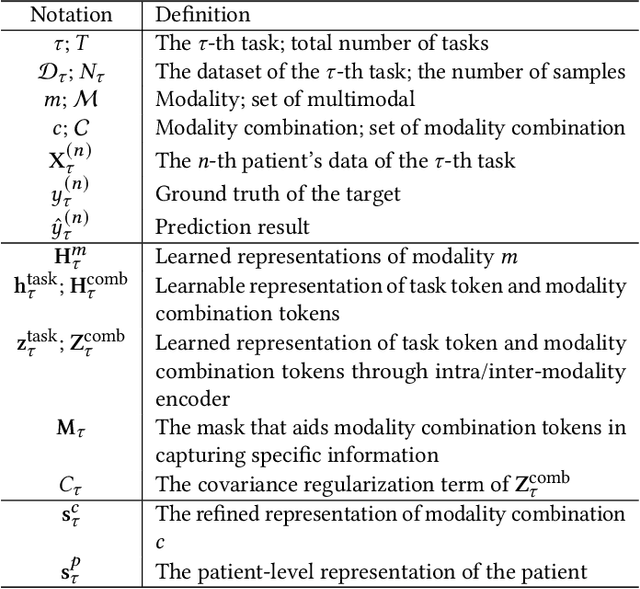

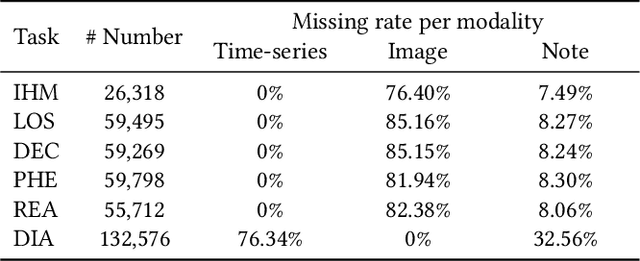
Abstract:Multimodal electronic health record (EHR) data can offer a holistic assessment of a patient's health status, supporting various predictive healthcare tasks. Recently, several studies have embraced the multitask learning approach in the healthcare domain, exploiting the inherent correlations among clinical tasks to predict multiple outcomes simultaneously. However, existing methods necessitate samples to possess complete labels for all tasks, which places heavy demands on the data and restricts the flexibility of the model. Meanwhile, within a multitask framework with multimodal inputs, how to comprehensively consider the information disparity among modalities and among tasks still remains a challenging problem. To tackle these issues, a unified healthcare prediction model, also named by \textbf{FlexCare}, is proposed to flexibly accommodate incomplete multimodal inputs, promoting the adaption to multiple healthcare tasks. The proposed model breaks the conventional paradigm of parallel multitask prediction by decomposing it into a series of asynchronous single-task prediction. Specifically, a task-agnostic multimodal information extraction module is presented to capture decorrelated representations of diverse intra- and inter-modality patterns. Taking full account of the information disparities between different modalities and different tasks, we present a task-guided hierarchical multimodal fusion module that integrates the refined modality-level representations into an individual patient-level representation. Experimental results on multiple tasks from MIMIC-IV/MIMIC-CXR/MIMIC-NOTE datasets demonstrate the effectiveness of the proposed method. Additionally, further analysis underscores the feasibility and potential of employing such a multitask strategy in the healthcare domain. The source code is available at https://github.com/mhxu1998/FlexCare.
Lancet: Accelerating Mixture-of-Experts Training via Whole Graph Computation-Communication Overlapping
Apr 30, 2024



Abstract:The Mixture-of-Expert (MoE) technique plays a crucial role in expanding the size of DNN model parameters. However, it faces the challenge of extended all-to-all communication latency during the training process. Existing methods attempt to mitigate this issue by overlapping all-to-all with expert computation. Yet, these methods frequently fall short of achieving sufficient overlap, consequently restricting the potential for performance enhancements. In our study, we extend the scope of this challenge by considering overlap at the broader training graph level. During the forward pass, we enable non-MoE computations to overlap with all-to-all through careful partitioning and pipelining. In the backward pass, we achieve overlap with all-to-all by scheduling gradient weight computations. We implement these techniques in Lancet, a system using compiler-based optimization to automatically enhance MoE model training. Our extensive evaluation reveals that Lancet significantly reduces the time devoted to non-overlapping communication, by as much as 77%. Moreover, it achieves a notable end-to-end speedup of up to 1.3 times when compared to the state-of-the-art solutions.
DualFluidNet: an Attention-based Dual-pipeline Network for Accurate and Generalizable Fluid-solid Coupled Simulation
Dec 28, 2023
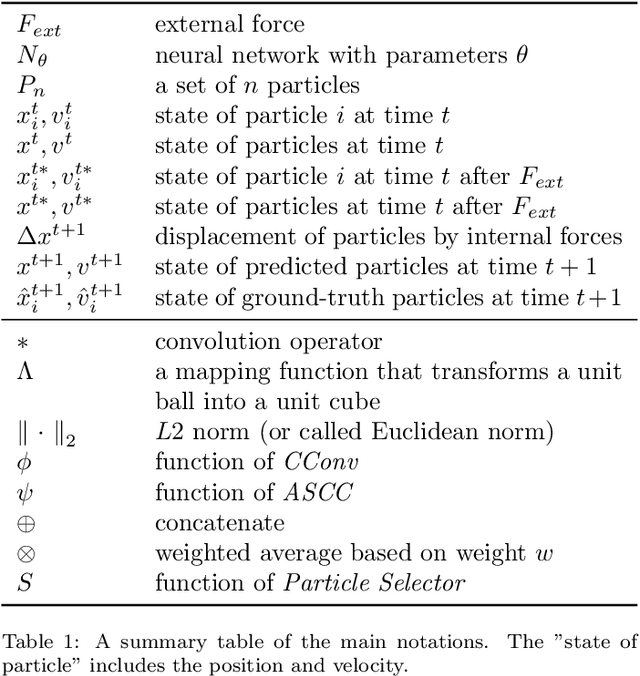


Abstract:Fluid motion can be considered as point cloud transformation when adopted by a Lagrangian description. Compared to traditional numerical analysis methods, using machine learning techniques to learn physics simulations can achieve near accuracy, while significantly increasing efficiency. In this paper, we propose an innovative approach for 3D fluid simulations utilizing an Attention-based Dual-pipeline Network, which employs a dual-pipeline architecture, seamlessly integrated with an Attention-based Feature Fusion Module. Unlike previous single-pipeline approaches, we find that a well-designed dual-pipeline approach achieves a better balance between global fluid control and physical law constraints. Furthermore, we design a Type-aware Input Module to adaptively recognize particles of different types and perform feature fusion afterward, such that fluid-solid coupling issues can be better dealt with. The experiments show that our approach significantly increases the accuracy of fluid simulation predictions and enhances generalizability to previously unseen scenarios. We demonstrate its superior performance over the state-of-the-art approaches across various metrics.
Contractive error feedback for gradient compression
Dec 13, 2023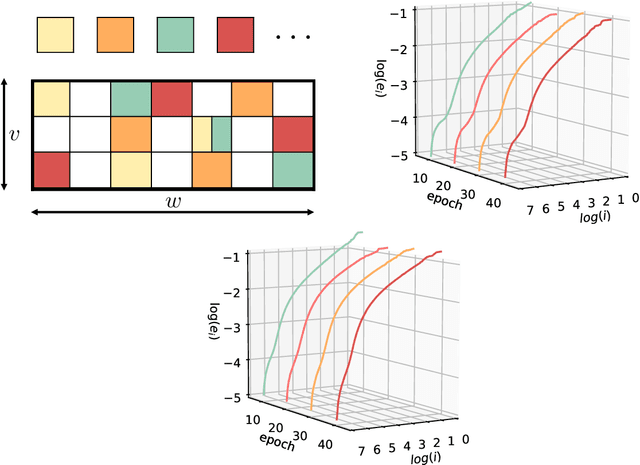

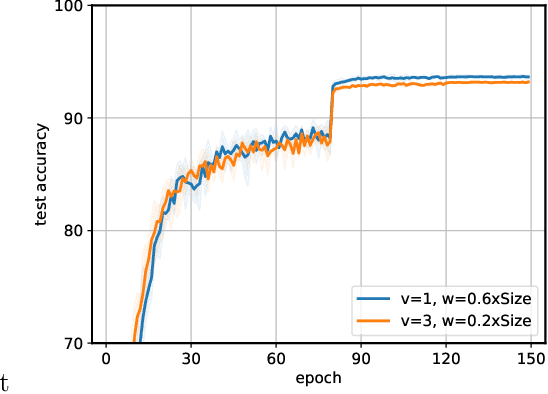
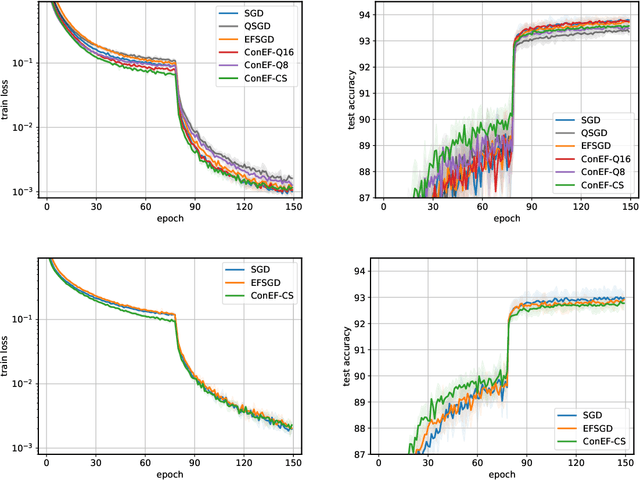
Abstract:On-device memory concerns in distributed deep learning have become severe due to (i) the growth of model size in multi-GPU training, and (ii) the wide adoption of deep neural networks for federated learning on IoT devices which have limited storage. In such settings, communication efficient optimization methods are attractive alternatives, however they still struggle with memory issues. To tackle these challenges, we propose an communication efficient method called contractive error feedback (ConEF). As opposed to SGD with error-feedback (EFSGD) that inefficiently manages memory, ConEF obtains the sweet spot of convergence and memory usage, and achieves communication efficiency by leveraging biased and all-reducable gradient compression. We empirically validate ConEF on various learning tasks that include image classification, language modeling, and machine translation and observe that ConEF saves 80\% - 90\% of the extra memory in EFSGD with almost no loss on test performance, while also achieving 1.3x - 5x speedup of SGD. Through our work, we also demonstrate the feasibility and convergence of ConEF to clear up the theoretical barrier of integrating ConEF to popular memory efficient frameworks such as ZeRO-3.
DynaPipe: Optimizing Multi-task Training through Dynamic Pipelines
Nov 17, 2023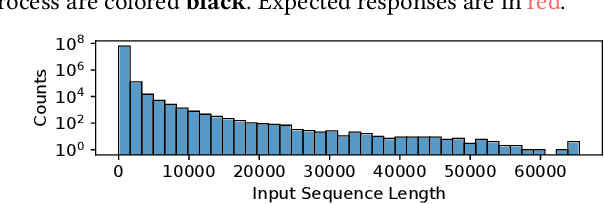
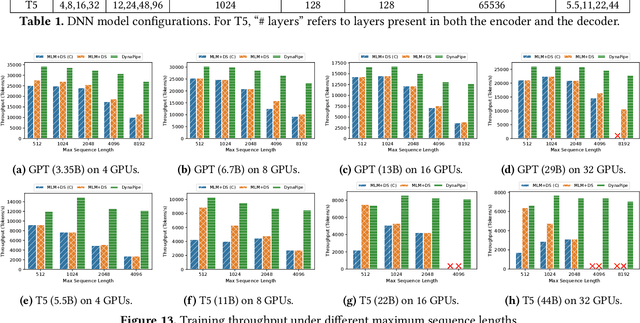
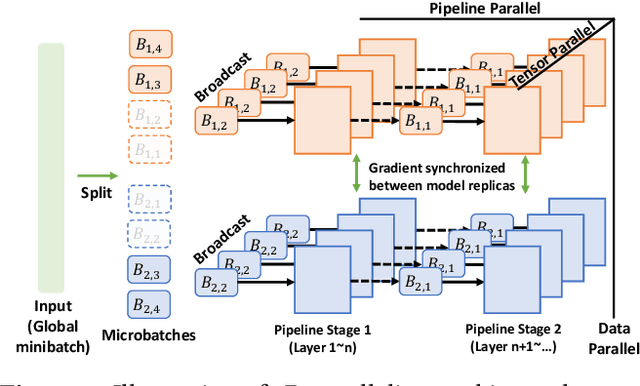
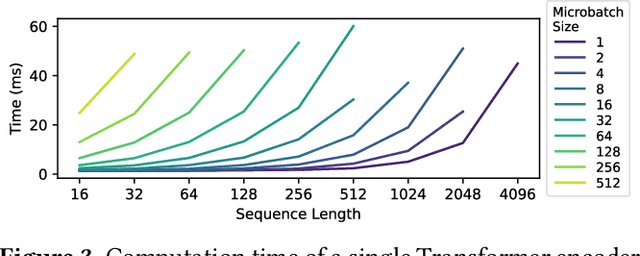
Abstract:Multi-task model training has been adopted to enable a single deep neural network model (often a large language model) to handle multiple tasks (e.g., question answering and text summarization). Multi-task training commonly receives input sequences of highly different lengths due to the diverse contexts of different tasks. Padding (to the same sequence length) or packing (short examples into long sequences of the same length) is usually adopted to prepare input samples for model training, which is nonetheless not space or computation efficient. This paper proposes a dynamic micro-batching approach to tackle sequence length variation and enable efficient multi-task model training. We advocate pipeline-parallel training of the large model with variable-length micro-batches, each of which potentially comprises a different number of samples. We optimize micro-batch construction using a dynamic programming-based approach, and handle micro-batch execution time variation through dynamic pipeline and communication scheduling, enabling highly efficient pipeline training. Extensive evaluation on the FLANv2 dataset demonstrates up to 4.39x higher training throughput when training T5, and 3.25x when training GPT, as compared with packing-based baselines. DynaPipe's source code is publicly available at https://github.com/awslabs/optimizing-multitask-training-through-dynamic-pipelines.
Unleashing the potential of GNNs via Bi-directional Knowledge Transfer
Oct 26, 2023
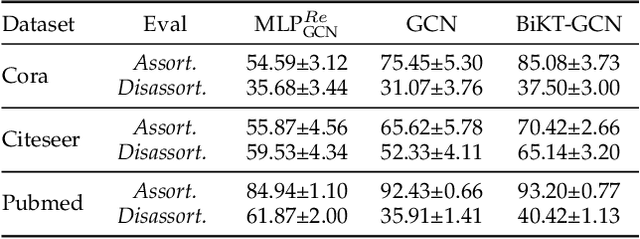

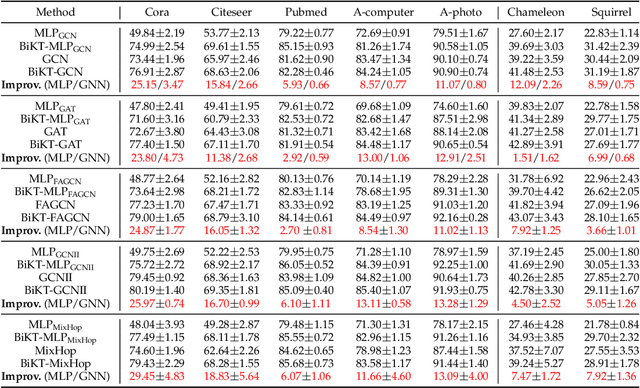
Abstract:Based on the message-passing paradigm, there has been an amount of research proposing diverse and impressive feature propagation mechanisms to improve the performance of GNNs. However, less focus has been put on feature transformation, another major operation of the message-passing framework. In this paper, we first empirically investigate the performance of the feature transformation operation in several typical GNNs. Unexpectedly, we notice that GNNs do not completely free up the power of the inherent feature transformation operation. By this observation, we propose the Bi-directional Knowledge Transfer (BiKT), a plug-and-play approach to unleash the potential of the feature transformation operations without modifying the original architecture. Taking the feature transformation operation as a derived representation learning model that shares parameters with the original GNN, the direct prediction by this model provides a topological-agnostic knowledge feedback that can further instruct the learning of GNN and the feature transformations therein. On this basis, BiKT not only allows us to acquire knowledge from both the GNN and its derived model but promotes each other by injecting the knowledge into the other. In addition, a theoretical analysis is further provided to demonstrate that BiKT improves the generalization bound of the GNNs from the perspective of domain adaption. An extensive group of experiments on up to 7 datasets with 5 typical GNNs demonstrates that BiKT brings up to 0.5% - 4% performance gain over the original GNN, which means a boosted GNN is obtained. Meanwhile, the derived model also shows a powerful performance to compete with or even surpass the original GNN, enabling us to flexibly apply it independently to some other specific downstream tasks.
 Add to Chrome
Add to Chrome Add to Firefox
Add to Firefox Add to Edge
Add to Edge